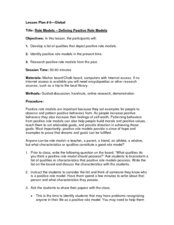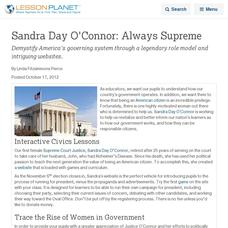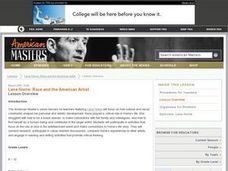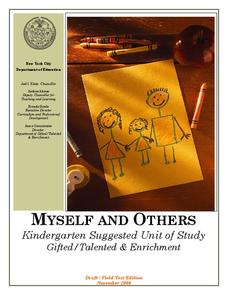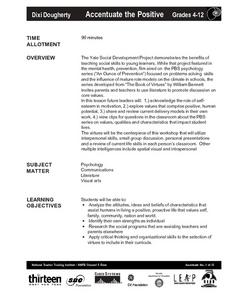Curated OER
Role Models - Defining Positive Role Models
Being able to identify what characteristics make a good role model is one way for students to better understand their own positive behaviors. The class brainstorms what characteristics make up a good role model, research a role model...
Curated OER
Role Models
Students consider what makes a role model. In this positive qualities lesson, students read and discuss several books that have characters describing themselves in a positive manner. Students illustrate a self portrait, remembering to...
Learning to Give
Your Place in the Community
Learners identify their beliefs and values and compare how these values relate to those of their community. They then determine how their values affect the roles they play in different situations. A quiz about values and beliefs...
Council for the Curriculum, Examinations and Assessment
Morals, Values and Beliefs
Your personality is based on the things you believe in, the morals you abide by, and the values upon which you make your decisions. Delve into a set of lessons about values and moral framework with your eighth graders as...
Biz Kids
Understanding Business Ethics
After screening an episode by BizKids, scholars show what they know about business vocabulary, then take part in grand conversations about role models and ethical dilemmas.
Curated OER
Modeling Reality
Students identify what a role model is and what characteristics such a person should possess. They discuss a new trend in character role model figurines, which some believe perpetuate racial and ethnic stereotypes.
Curated OER
Sandra Day O'Connor: Always Supreme
Demystify America's governing system through a legendary role model and a fabulous website.
Curated OER
Understanding Other People's Decisions
Students analyze people's choices from different points of view. They read different scenarios and explain how they would react personally in that situation. Then they analyze what they would do in another character's position and...
Curated OER
Building a Model Courtroom
Young scholars construct a model of the Supreme Court's courtroom. They design the courtroom in such a way so that the architecture and furnishings in the courtroom represent the neutrality and power of the court.
Lehigh University
Glory (1989) - Should it be Shown in Class?
This is a fantastic activity that prompts learners to think like educators and consider the value of a historically based film beyond just the accuracy of information. Your young historians will work in groups to do a close reading and...
Curated OER
UN Conference on the Impact of Civil War on the Common Person
Students simulate understanding of conflict or civil war they researched, and role play character they developed at model UN conference on the impact of civil war on the common person.
Curated OER
What Will I Be When I Get Big
Students research a famous person, consider what character values make this person a good role model and write a personal vision statement that maps out how to build similar character traits in their own lives.
Curated OER
Mapping the Mediasphere
Students compare/contrast the media messages they see in two different communities in their city. They list the elements of art and the principles of design in the photographs they have taken in those two different communities. They...
Briscoe Center for American History
Applying the SOAPS Method of Analyzing Historical Documents
Young historians use the SOAPS (Speaker, Occasion, Audience, Purpose, Subject) method of questioning to determine the historical value of primary source documents. The third in a series of five lessons that model for learners how...
Civil War Trust
Civil War Personalities Lesson Plan
Caring, trustworthiness, and responsibility—these are only a few character traits in focus of a lesson based on stories from the Civil War era. Class members explore several influential lives while reading biographies that highlight...
Smithsonian Institution
Dia de los Muertos: Honoring our Ancestors Through Community Celebration
Oral storytelling has been an important part of every culture. The time-honored practice uses stories as a conduit for a culture's values and customs from one generation to the next. Keep the tradition going with a family interview...
Curated OER
Japanese Women - ESL Style
Young scholars read two articles discussing traditional and modern gender roles in Japan. Students complete a worksheet and participate in a discussion about the articles, clarifying some of their own opinions about gender roles.
Curated OER
Model Parliaments: Creating a Real Senate
Students discover how the Canadian Parliamentary works and how to tolerate other people's point of view by participating in a model Parliament.
Curated OER
Lena Horne: Race and the American Artist
Learners examine how race played a critical role in Lena Horne's life. They conduct Internet research, participate in a class debate, write a letter, and create a presentation based on their Internet research.
Curated OER
The Business of Interest
Students learn about finance and money management and use math to solve problems, communicate, and explore real life situations as they deal with banks. In this financial management lesson plan, students apply their math skills to real...
New York City Department of Education
Myself and Others
Self reflection is an important skill to reinforce in our children, and it's especially helpful to help them realize who they are in the context of their environment. A collection of lessons about self image and community encourage...
Curated OER
Accentuate the Positive
Students analyze the attitudes, ideas and beliefs of characteristics that
assist humans in living a positive, proactive life that values self,
family, community, nation and world. Students identify their own strengths as individual....
Curated OER
The Charity Model of Disability
Students examine the ways charities such as the March of Dimes collect funds. They analyze the perceptions people have about these charities and evaluate sources of citizen's rights.
Curated OER
Government: The Mystery Epidemic
Students are able to identify some roles of government in dealing with the prevention and treatment of skin cancer. They are able to list two reasons why the occurrence of skin cancer in youths has increased.
